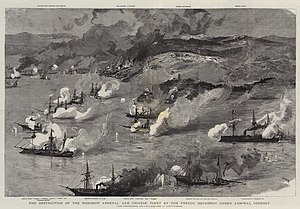Battle of Fuzhou
| date | 23 August 1884 |
|---|---|
| place | Fuzhou |
| output | Victory of the French Far East Squadron, destruction of the Chinese fleet |
| Parties to the conflict | |
|---|---|
| Commander | |
| Troop strength | |
| 22 ships (including 11 junks ) | 13 ships |
| losses | |
|
796 dead, 150 wounded, 51 missing, 9 sunken ships, 10+ damaged ships |
10 dead, 48 wounded, 2 damaged ships |
Fuzhou - Keelung - Tamsui - Kep - Tuyen Quang - Yu Oc - Nui Bop - Shipu - Lang Son - Dong Dang - Zhenhai - Hoa Moc - Phu Lam Tao - Bang Bo - Pescadoren
The sea battle of Fuzhou was a battle in the Sino-French War . In the battle of August 23, 1884, the French Far East Squadron sank the Chinese fleet almost completely within a very short time.
background
The core of the conflict between the Chinese Empire of the Qing Dynasty and France was control over Vietnam . France had shown interest in Vietnam since the end of the 18th century and annexed several regions in southern Vietnam in 1862. French traders soon tried to navigate the Red River and thereby facilitate trade with China. This trade was prevented or at least made more difficult by the Black Flags , a bandit group in North Vietnam. As a result, a French delegation led by Henri Rivière was sent to Hanoi . Contrary to their orders, the French stormed the citadel of Hanoi and thus aroused the suspicion of the Vietnamese and their protective power China. The Chinese Empire then provided military and material aid to the Vietnamese and the Black Flags in the fight for control of the Tonkin area in northern Vietnam. After Chinese defeats in the war, the Tientsin Agreement was concluded on May 11, 1884, granting France control over Tonkin. In June 1884, however, there was renewed armed conflict between the Chinese Guangxi Army and a French column under Alphonse Dugenne. After negotiations between the Chinese Empire and France failed, the conflict flared up again.
Preparation for battle
After the negotiation failed, Admiral Courbet was ordered to attack the Chinese fleet in the port of Fuzhou. The flagship of the French fleet under Courbet was the Bayard, the counterpart of the Chinese fleet was the Yangwu.
course
The French Far East Squadron opened the battle on August 23, 1884 at 2 p.m. The Chinese flagship was quickly damaged by a French torpedo boat . Like many other ships in the Chinese fleet, the Zhenwei was sunk by French shells . Given the heavy casualties, the Chinese focused their attacks on the French flagship in hopes of killing Courbet and turning the tide. Executives aboard the French flagship were injured during this attack, but Courbet was unharmed. Eventually the attack was repulsed, and at 5 p.m. the fighting ended. Only the ships Fupo and Yixin were able to survive the battle on the Chinese side unscathed. During the night the Chinese made several unsuccessful attacks on the French ships.
The battle was watched by neutral British and American ships.
consequences
The following day, the French squadron bombed the Chinese shipyard and other military positions on the coast.
The French attack led to the final breakdown of negotiations and diplomatic relations between the Chinese Empire and France.
Individual evidence
- ↑ a b c boxer rebellion: Battle of Fuzhou - 1884 . In: The Boxer Rebellion Project . May 18, 2017 ( boxer-rebellion.com [accessed February 9, 2018]).
- ^ Battle of Fuzhou . In: Ranker . ( ranker.com [accessed February 9, 2018]).
- ^ Loyd E. Eastman: Throne and Mandarins: China`s Search for a Policy during the Sino-French Controversy. 1967, pp. 51-57.
- ^ Louis Roger Gérard de Marolles: La dernière Campagne du Commandant Rivière 1881-1883. 1932, pp. 75-92.
- ↑ When China and France went to war: 130 years since forgotten conflict . In: South China Morning Post . ( scmp.com [accessed February 9, 2018]).
- ↑ Lung Chang: 越南 與 中法 戰爭. 1993, 280-283.

